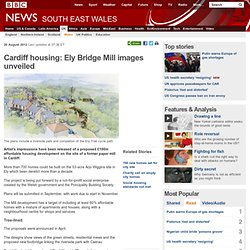

Streetlife - the local social network. Cardiff housing: Ely Bridge Mill images unveiled. 20 August 2012Last updated at 07:38 ET The plans include a riverside park and completion of the Ely Trail cycle path Artist's impressions have been released of a proposed £100m affordable housing development on the site of a former paper mill in Cardiff.

More than 700 homes could be built on the 53-acre Arjo Wiggins site in Ely which been derelict more than a decade. The project is being put forward by a not-for-profit social enterprise created by the Welsh government and the Principality Building Society. Plans will be submitted in September, with work due to start in November. The Mill development has a target of including at least 60% affordable homes with a mixture of apartments and houses, along with a neighbourhood centre for shops and services. Tree-lined. Y Wladfa. Y Wladfa[2] ('The Colony'), or more fully Y Wladfa Gymreig[3] ('The Welsh Colony'), also historically and occasionally Y Wladychfa[4] and Y Wladychfa Gymreig,[5] is a Welsh settlement in Argentina, which began in 1865 and occurred mainly along the coast of Chubut Province in the far southern region of Patagonia.

In the 19th and early 20th century the Argentine government encouraged immigration from Europe to populate the country outside the Buenos Aires region; between 1856 and 1875 thirty-four settlements of immigrants of various nationalities were established in Santa Fe and Entre Ríos. History[edit] First settlers 1865[edit] A Welsh tea house in Chubut. The idea of a Welsh colony in South America was put forward by Professor Michael D. Once they reached the valley of the Chubut River, their first settlement was a small fortress on the site which later became the town of Rawson, now the capital of Chubut province. Consolidation 1866–1888[edit] Welsh traditions in Rawson.
Map[edit] Trelew. Welsh language. Welsh (Cymraeg or y Gymraeg, pronounced [kəmˈrɑːɨɡ, ə ɡəmˈrɑːɨɡ]) is a member of the Brythonic branch of the Celtic languages spoken natively in Wales, by some along the Welsh border in England, and in Y Wladfa (the Welsh colony in Chubut Province, Argentina).[9] Historically it has also been known in English as "the British tongue",[10] "Cambrian",[11] "Cambric"[12] and "Cymric".[13] The 2011 UK Census counted almost 3 million residents of Wales.

Of these, 73% (2.2 million) reported having no Welsh language skills. A greeting in Welsh is one of 55 languages included on the Voyager Golden Record chosen to be representative of Earth in NASA's Voyager program launched in 1977.[17] The greetings are unique to each language, with the Welsh greeting being Iechyd da i chwi yn awr ac yn oesoedd, which translates into English as "Good health to you now and forever".[18] Wales.com - Welcome to the official gateway to Wales. Wales. Wales ( i/ˈweɪlz/; Welsh: Cymru [ˈkəm.rɨ] ( )) is a country that is part of the United Kingdom and the island of Great Britain,[6] bordered by England to its east and the Atlantic Ocean and Irish Sea to its west. It had a population in 2011 of 3,063,456 and has a total area of 20,779 km2 (8,023 sq mi).
Wales has over 1,680 miles (2,700 km) of coastline and is largely mountainous, with its highest peaks in the north and central areas, including Snowdon (Yr Wyddfa), its highest summit. The country lies within the north temperate zone and has a changeable, maritime climate. At the dawn of the Industrial Revolution, development of the mining and metallurgical industries transformed the country from an agricultural society into an industrial nation; the South Wales coalfield's exploitation caused a rapid expansion of Wales' population. Etymology.